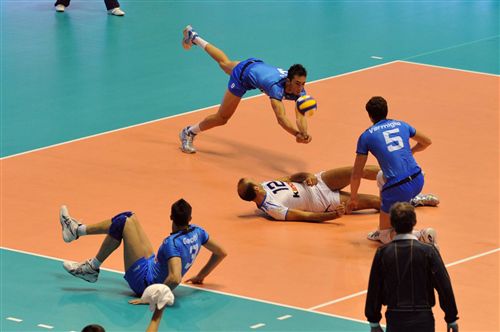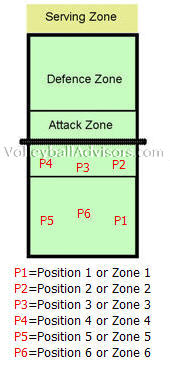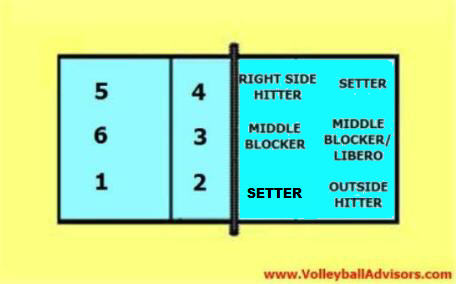Volleyball 6 2 rotation - How to Line up?
Explore Volleyball 6 2 rotation line ups.

In addition to 5-1, 6-2 volleyball rotation is the most common line up in volleyball.
You’ll find simple explanations how to line up for 6-2.
And information about positions where players should move after the serve.
Volleyball 6 2 Rotation – Learn Different Court Positions
In the text we talk about rotational
positions and playing
positions.What is a rotational position?
Volleyball court has six steady rotational positions. Those are steady positions on certain spots on the court - a player rotates from one rotational position to the next rotational position when sideout occurs.Rotational positions are called for example Zone 1, Zone 2, Zone 3, etc.
From rotational position (Zone 1, Zone 2, etc) the player is allowed to move to the playing position (middle blocker, right side hitter, etc) after the serve when appropriate.

Most often these rotational positions are being called..
P1; Right BackP2; Right Front
P3; Middle Front
P4; Left Front
P5; Left Back
P6; Middle Back
Volleyball 6 2
rotation – How to Line Up on 6-2 Offense?
On the following picture there is one usual line up when using
volleyball 6 2 rotation.
This is not the only way to line up. Once again, there are not one right way to play volleyball – you may see coaches using different formations.
The basic
idea behind volleyball 6-2 rotation
- it allows team to have 3 offensive players on
the front row all the times.
- two setters are in the opposite rotating
positions
- two middle blockers are in the opposite
rotating positions
- two wing-hitters (on 5-1 you could call them outside hitter and right side hitter) are in the opposite rotating positions.
Comparing
Volleyball 6 2 Rotation to 5-1 Offense
When comparing to 5-1 offense, on 6-2- The opposite hitter is replaced by another
setter
- The setter in the back row sets the ball to
three
offensive players.
- The setter plays as a hitter in the front row, since other setter has setting responsibilities in the back row. (On 6-2 the setter is often replaced by a hitter in the front row - therefore may not play front row.)
What rotational positions players move after own serve or serve receive
on volleyball 6-2 rotation?
Where do the players move when appropriate?- Just like in 5-1 offense a back row setter always places
herself on the Zone 1 position, in other words to the
right back
position.
- The
front row setter is often placed on the right front position.
Then the front row setter is able to set the ball, if the back row
setter has to play defense. This is not necessary though, some teams
use the setter on the left side also.
Other players positions are naturally.. - Middle
blockers play on the middle front position, or
the middle back position, if not being replaced by the
libero. (Often they won't play back row at all because they
are replaced by the libero. In international volleyball they
are usually replaced after the serve, since liberos are not allowed to
serve.)
- If
the libero is being used, usually the libero is placed on the
left back position.
- The right side hitter and outside hitter in the
front row has to share the hitting duties with setters. Also
they may have more 3 meter (10 feet) hitting
responsibilities since the opposite hitter is no longer in the line up.
Notice that many leagues in United States allow unlimited subs, so the setter is often replaced by an offensive player when entering the front row. Therefore volleyball 6-2 offense is more popular in United States.
In international volleyball substitutions are limited, so the system of two setters is not being used as much.




